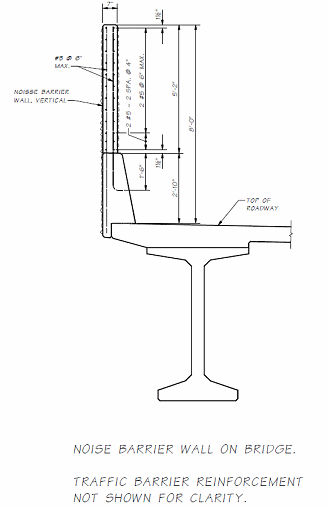
Design Memorandum
TO: All Design Section Staff
FROM: Bijan Khaleghi
DATE: July 20, 2011
SUBJECT: New LRFD Chapter 15 - Design Of Sound Barriers
This memorandum incorporates the new AASHTO LRFD Bridge Design Specifications Chapter 15 for “Design of Sound Barriers” to WSDOT design practice. This memorandum replaces the BDM Section 3.12 on “Noise Barriers”
1. The structural design of WSDOT noise barrier walls which are either ground-mounted or structure-mounted shall
conform to the requirements of attachments A and C of this document. The requirement for foundation design of noise barrier walls shall
conform to WSDOT Geotechnical Design Manual Chapter 17, “Foundation Design for Noise Barriers.”
2. The design requirement for noise barrier walls on bridges and walls are as follows:
- The total height of noise barrier walls on bridges, from top of slab to top of noise barrier wall, shall be limited to 8'-0"
- The total height of noise barrier wall on retaining walls, from top of roadway to top of noise barrier wall, shall be limited to 14'-0"
- Noise barrier wall thickness shall be 7" minimum with two layers of reinforcing bars in the cross section, with 1˝” minimum concrete cover on both faces. Self-consolidating concrete (SCC) shall be specified for cast-in-place (CIP) concrete noise walls. If conventional concrete is used for CIP noise walls, the minimum wall thickness shall be increased to 8” with1˝” minimum concrete cover on both faces and 2˝” minimum opening between two layers of reinforcing bars. The minimum wall thickness of 7” with1˝” minimum concrete cover on both faces, as shown in the attached detail, is adequate for precast noise walls
3. All noise barriers which will be mounted on existing structures, supported by existing structures, or constructed as part of a new
structure, shall be evaluated by the Bridge and Structures office and the Geotechnical Division.
Background:
AASHTO Bridge Engineers in their 2011 Annual meeting have approved the incorporation of a new Chapter 15 on “Design of Sound Barriers” to the LRFD Bridge Design Specifications. This Section applies to the structural design of noise barrier walls which are either ground-mounted or structure-mounted and to the design of the foundations of ground-mounted noise barrier walls. This Section specifies the design forces, and the design requirements unique to noise barrier walls constructed along highways.
The 7” minimum wall thickness is suitable for precast noise walls. Precast walls are almost always cast flat, so the limited concrete cover and space between the mats will not pose challenges for concrete placement. For CIP noise walls, the 7” wall thickness with 1˝” cover is not sufficient to get a concrete tremie into the wall for concrete placement. To achieve better concrete placement and improve constructability, the minimum wall thickness shall be increased to 8” with 2˝” minimum clearance between the mats of reinforcing to get a concrete tremie into the wall for concrete placement. The 7” minimum wall thickness is suitable if self-consolidating concrete is required for CIP noise walls. SCC could be end-dumped into the top of the wall without segregating.
If you have any questions regarding these issues, please contact Bijan Khaleghi at 360-705-7181.
cc: Mark Gaines, Bridge Construction - 47354
F. Posner, Bridge and Structures – 47340
Note: Click here for a PDF of this design memo.

|

